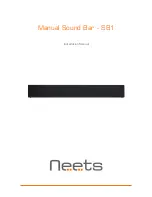
English
48
Fig. 2/20
Fig. 2/23
Fig. 2/24
Fig. 2/28
Connecting the Audio cable
HDMI
Connection using a HDMI cable ensures a very high replay quality.
HDMI is used to transmit both Video and Audio data.
1. Plug the HDMI jack into the socket on the back of the player.
2. Plug the HDMI jack into the corresponding socket on your playback
device.
NOTE:
In the „Video Settings“ menu select the submenu „HDMI Setup“. Then
select the „On“ option in the „HDMI“ menu.
Component Video
Connection using a Component Video cable ensures a very high replay
quality.
Component Video transmits only Video signals.
1. Plug each of the three jacks into the corresponding sockets on the
DVD-Player.
2. Plug the jacks into the corresponding socket on your playback device.
In the „Video Settings“ menu select the submenu „Component“. Then
select the „YUV“ option.
S-Video
Connection using a S-Video cable ensures a very high replay quality.
Component Video transmits only Video signals.
1. Plug the S-Video jack into the socket on the back of the player.
2. Plug the S-Video jack into the corresponding socket on your playback
device.
Composite-Video
Composite-Video is used to transmit only Video data.
1. Plug the Composite-Video jack into the socket on the back of the
player.
2. Plug the Composite-Video jack into the corresponding socket on your
playback device.
You can choose from three transmission methods for audio signals.
You must generally choose fi rst whether you would like to have the sound
coming from your TV, or through a Stereo Amplifi er. The Audio cable must
then be connected to the TV or an amplifi er accordingly.
NOTE:
If your amplifi er is equipped with a digital output, you should use the
amplifi er. You will experience a much better audio quality, and the
installation is much easier.
05-DVD 4619 HC_GB.indd 48
05-DVD 4619 HC_GB.indd 48
28.05.2009 8:08:56 Uhr
28.05.2009 8:08:56 Uhr
















































